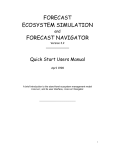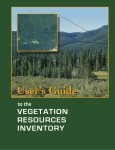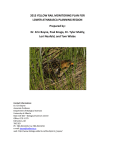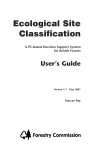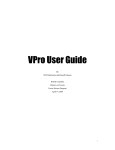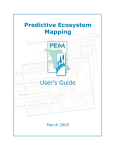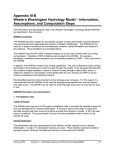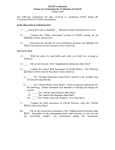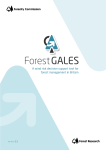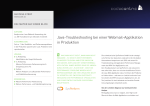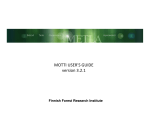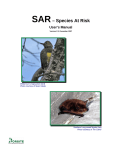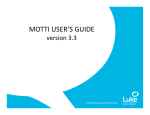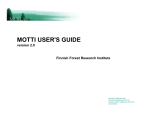Download Enhanced Wetland Classification Inferred Products User Guide
Transcript
Enhanced Wetland Classification Inferred Products User Guide Version 1.0 September 2011 Table of Contents List of Figures and Tables................................................................................................... 3 Introduction ......................................................................................................................... 4 Inferred Product Background .............................................................................................. 5 Environmental determinants of wetlands........................................................................ 5 Classification Schemes ................................................................................................... 7 Environmental Determinants – Inferred Products .............................................................. 7 Soil Moisture Factor ....................................................................................................... 7 Description of moisture classes ................................................................................ 10 Inferred Soil Moisture ............................................................................................... 15 Hydrodynamic Factor ................................................................................................... 16 Description of Hydrodynamic Classes...................................................................... 17 Inferred Hydrodynamics ........................................................................................... 20 Nutrient Availability Factor .......................................................................................... 21 Description of Nutrient Regime Classes ................................................................... 24 Inferred Nutrient Availability ................................................................................... 27 Conclusion and Summary ................................................................................................. 28 References ......................................................................................................................... 29 © Ducks Unlimited Canada 2 List of Figures and Tables Figure 1. Landscape cross-section of Boreal Plains wetlands showing the relative positions of the major wetland types and the corresponding positions of water regime, soil regime, and nutrient status (adapted to the Boreal Plains and expanded from Harris et. al. 1996). ..............................5 Figure 2. Edatopic grid showing the distribution of wetland classes in relation to inferred moisture, nutrient, and hydrodynamic regimes.............................................................................6 Table 1. Relative soil moisture code derivation guide. Adapted and expanded from Beckingham and Archibald 1996. ......................................................................................................................8 Figure 3. General relationship between landscape position and moisture code. ..........................9 Table 2. Enhanced Wetland Classification class cross-walk to inferred soil moisture classes. .15 Figure 4. An example of the soil moisture inferred product from an area near Ft. Nelson, BC. 15 Figure 5. A marsh area in the boreal with a large difference in water table elevation throughout the growing season......................................................................................................................16 Table 3. Inferred hydrodynamic factor classes for wetlands. .....................................................17 Table 4. Enhanced Wetland Classification class cross-walk to inferred hydrodynamic classes.20 Figure 6. An example of the hydrodynamic product from an area near Ft. Nelson, BC. ...........20 Table 5. Ground-level determinants of nutrient regime code (adapted and expanded from Mackenzie and Moran 2004). .....................................................................................................22 Table 6. General characteristics of water with different trophic status (adapted from Mackenzie and Moran, 2004) (also shown in Figure 9)................................................................................22 Figure 7. Field photos of water bodies and the association between water color and nutrient regime. ........................................................................................................................................23 Table 7. Enhanced Wetland Classification class cross-walk to inferred nutrient classes ..........27 Figure 8. An example of the inferred nutrient regime product from an area near Ft. Nelson, BC. .....................................................................................................................................................27 © Ducks Unlimited Canada 3 Introduction In recent years, Ducks Unlimited Canada (DUC) has initiated an increasing number of research and inventory programs that highlight the importance of boreal wetlands in Canada. It is well established that these wetland ecosystems are important in that they provide numerous ecological goods and services, some of which include: wetlands filter our water; recharge our groundwater supplies; mitigate the effects of flooding and droughts; remove carbon from the atmosphere; as well as support diverse flora and fauna. In direct contrast to this vast and important global resource is the relative lack of information on Canada’s boreal wetland resources, specifically wetland maps that identify the type, extent, and distribution of these systems. These maps, which help focus DUC’s conservation efforts, are needed in part to determine critical waterfowl habitat, aid with impact assessments of industrial activities, provide critical inputs to scientific research and modeling efforts such as climate change, and support various international/national/provincial wetland mapping/monitoring programs (e.g. North American Waterfowl Management Plan, Canadian Wetland Inventory, Alberta’s Water For Life program, etc.). Ducks Unlimited has been leading the effort to provide detailed and accurate wetland maps for large areas of the western boreal forest. This enhanced wetland classification (EWC) effort is a multi-partner collaboration with several international (US Fish & Wildlife Service, US Forest Service, and the Pew Charitable Trusts), national (Environment Canada), provincial and territorial agencies and industries (various forestry and energy companies). To date, nearly 50 million hectares of wetlands have been mapped. This inventory effort is unique in that it uses detailed field data collected in helicopters to help guide the classification of large-scale satellite images to map wetlands. Due to the complexity and diversity of wetlands in the Boreal Plains ecozone, a field guide to boreal wetlands was developed by Ducks Unlimited biologists to help understand and classify the various types of wetlands (bogs, fens, swamps, marshes and shallow open water) found in this region (Smith et al 2007). A classification approach that uses image-object oriented software was also developed to meet the challenges of mapping diverse and predominantly interconnected wetland types over large geographic areas. This approach is flexible enough to be adapted and applied to other boreal regions throughout Canada. These mapping products have become the cornerstone of DUC’s Western Boreal Program by providing baseline data to undertake other inventory elements, including waterbird surveys, associated research projects and conservation planning. Beyond the baseline data, these wetland maps can also be used to create various inferred products (such as relative nutrient regime, relative soil moisture regime, and relative hydrodynamic regime) based on general groupings of the EWC wetland types. This guide describes how these inferred products are generated, and how they can be used to provide information on how different wetlands function. This detailed information on the underlying ecological determinants of wetland ecosystems is critical in order to advance wetland conservation in the boreal forest. © Ducks Unlimited Canada 4 Inferred Product Background This section is directly taken from A field guide to the wetlands of the Boreal Plains Ecozone of Canada by Smith et al. 2007. It is referenced here to serve as a background on how the inferred classes are represented on the landscape. Environmental determinants of wetlands The wetland vegetation communities that exist on the landscape are a result of the underlying factors forming them, including: geology, hydrology, nutrient availability, climate, position in the landscape etc. Of these factors, water table depth (hydrology), water flow (hydrodynamics), and nutrient availability are particularly important. Wetlands develop in response to these factors, and the resulting vegetation is comprised of species adapted in varying degrees to flooding frequency and duration, wave energy, and available dissolved minerals. Each wetland class has a set of environmental conditions which ultimately dictate the vegetation assemblages. These varying conditions and resulting vegetation indicator species can be used to distinguish between wetland classes. Figure 1 is a cross section of Boreal Plains wetlands showing the relationship between the various environmental determinants and the resulting vegetation communities. The enhanced wetland classification utilizes these differences in wetland conditions and vegetation to generate a descriptive key and a decision tree that enables the reader to classify a wetland to six major and nineteen minor wetland classes. Boreal Plains Wetland Cross Section Shallow/Open Shore Marshes Water Fens Minerotrophic Mineral Soil Woody Peat Sphagnum Peat Rich Fens Bogs Poor Fens Ombrotrophic Legend Permanently flooded to intermittently exposed Semi-permanently flooded to seasonally flooded Permanently to semi-permanently saturated No consistent contact with water table Swamps Upland Minerotrophic Low Water Level High Water Level Figure 1. Landscape cross-section of Boreal Plains wetlands showing the relative positions of the major wetland types and the corresponding positions of water regime, soil regime, and nutrient status (adapted to the Boreal Plains and expanded from Harris et. al. 1996). © Ducks Unlimited Canada 5 The field guide also provides a classification based on three factors: moisture regime, nutrient regime, and hydrodynamic regime. The relative combination of these factors is shown in edatopic grid format in Figure 2. For example, a field site with a very poor nutrient regime, hygric moisture regime, and a stagnant hydrodynamic regime would be a bog. The nutrient regime is shown on the x-axis, the moisture regime on the y-axis, and the hydrodynamic regime on the diagonal (2-d z-axis). This edatopic grid shows the relative distribution of major wetland classes according to the relative combination of each of the three inferred environmental determinants. na nt ic m na e dy m r o gi yd Re H ag ow g Sl vin o M St M Mesic ov g in Bogs D yn Hygric Swamps Fens ry i c Ve a m yn D Hydric Very Hydric ic Subhydric am Moisture Regime Subhygric Marshes Open Water Very Poor Poor Medium Rich Very Rich Excess Nutrient Regime Figure 2. Edatopic grid showing the distribution of wetland classes in relation to inferred moisture, nutrient, and hydrodynamic regimes. This edatopic grid is modified from similar existing grids based on ordination of species (MacKenzie and Moran 2004) and chemical and biotic gradients (Vitt et al. 1994) to represent the distribution of the various EWC major level wetland classes. Field data from over 5,000 (n=5063) field sites was used to determine the distribution of the various EWC major classes in relation to the various environmental determinants. EWC major classes with a majority of sites within a particular position were given precedence over EWC major classes with a minority of sites in the same position on the edatopic grid. © Ducks Unlimited Canada 6 Classification Schemes The inclusion of environmental determinants in the Enhanced Wetland Classification (EWC) and the class breakdowns listed in the following section allows for inferred products to be developed that map the distribution of hydrodynamics, soil moisture, and relative nutrient status based on the wetland classes in the EWC. The underlying assumption is that each wetland class can be assigned to a specific inferred class. While this may not be true in some cases (such as open water, which has a wide range of potential nutrient regime classes from 1-5), in many cases wetlands can be placed categories where they are most prevalent. For example, the majority of bogs can be placed in stagnant (hydrodynamic class), subhygric (moisture class), very poor (nutrient class) categories of the various environmental determinants. The primary inferred class for each wetland type was determined by a review of the field site database for all sites across the Boreal Plains ecozone (over 5,000 individual sites). The most commonly occurring inferred class for each wetland class was then determined. This classification scheme allows for a generalized cross-walk of EWC classes to their inferred classes. Environmental Determinants – Inferred Products The following sections provide a description of each inferred environmental determinant (nutrient regime, moisture regime, and hydrodynamic regime), along with the features used in the field to determine the appropriate wetland class (e.g., wet vs. dry, rich vs. poor, stagnant vs. dynamic). A description of each cross-walk from EWC minor class to majority environmental determinant class is also provided, along with a map example of the distribution on a sample boreal landscape. Soil Moisture Factor A key determinant (and indicator) of wetland presence/function is the relative position of the wetland on the landscape as it relates to soil moisture and hydrologic input source. Factors such as landscape position (visible), slope gradient (visible), water table location (visible or inferred), drainage class (visible), and vegetation community cues can all be used to assign soil moisture regime codes to any given wetland. In areas where ground-level site information can be easily collected, features such as surficial geology (soil type, texture, strata, depth to impermeable layer, parent material) and hydrology (soil moisture readings, depth to/height of water table measurements, etc.) would typically be used to assign soil moisture classes (SCWG 1998), however, due to cost and logistical restraints these factors often cannot be determined across much of the more remote access areas of the Boreal Plains. Therefore, this classification uses several inferred factors that can be visually observed and collected via aerial reconnaissance to assign a specific field site location to a moisture regime code to a field site location. This wetland classification system assigns relative moisture codes on a scale of 1 to 10 (adapted from Beckingham and Archibald 1996). These codes take into account both the relative drainage and the hydrologic input source to derive this relative scale of ten classes (Table 1). The inferred soil moisture code (and corresponding moisture class) presented here is a representation of the average amount of soil water available to vegetation for evapotranspiration. A diagram showing the relative position in the landscape where the moisture classes typically occur is shown in Figure 3. © Ducks Unlimited Canada 7 Table 1. Relative soil moisture code derivation guide. Adapted and expanded from Beckingham and Archibald 1996. General Water Hydrologic Position Soil Soil Slope Moisture Moisture Table Input Source On Moisture Drainage Gradient Code Class Location Landscape Regime Class1 (degrees) No Precipitation Ridge, crest Extremely Very Very Steep 1 Contact Xeric Rapid (>70°) Very Dry Well Precipitation Ridge, crest, Xeric Very Rapid Very Steep 2 Below upper slopes to Rapid (>70°) Surface Below Precipitation Upper Subxeric Rapid Steep 3 Dry Surface Slopes (31-70°) Below Precipitation Upper to Submesic Rapid to Steep 4 Surface Mid Slopes Well (31-70°) At/Below Precipitation/ Mid to Mesic Well to Slight to 5 Surface Groundwater Lower Moderately Moderate Mesic/ Slopes Well (2-30°) Moist At/Below Groundwater/ Domes, Subhygric Moderately Slight 6 Surface Precipitation Lower Well to (2-9°) Slopes to Imperfect Flat At/Above Surface/ Lower Hygric Imperfect to Slight 7 Surface Groundwater Slopes to Poor (2-9°) Wet Seepage Flat Above Surface/ Depressions Subhydric Poor to Slight 8 Surface Groundwater Very Poor (2-9°) Seepage Above Permanent Depressions Hydric Very Poor Flat 9 Very Wet Surface Water Table (<2°) Above Permanent Basin Extremely Water Flat (<2°) 10 Surface Water Table Hydric 1 Adapted from Soil Survey Division Staff (1993) © Ducks Unlimited Canada 8 Height 1-500 meters (vertically exaggerated) Ridge, Crest Depth of Surface Organic Layer Mineral Soils Bedrock Water Table Upper Slope Mid-Slopes Lower Slopes 1,2 3,4 5 6,7,8 Level 7,8,9 Receiving Depression 8,9,10 8,9 Dome 6 Moisture Code Figure 3. General relationship between landscape position and moisture code. It should be noted that throughout this guide, when we mention groundwater we refer to water that has been in contact with minerals/nutrients and includes shallow subsurface water, but rarely includes groundwater from deepwater aquifers. Deepwater aquifers are present in the Boreal Plains, but their connection to wetlands and discharge/recharge functions are not well understood and beyond the scope of this field guide. © Ducks Unlimited Canada 9 Description of moisture classes: The following description of each moisture class (and associated moisture code for tracking purposes) is intended to aid in field determination. The examples for the very dry regimes are from the Montane Cordillera (Extremely Xeric) and the Boreal Shield (Xeric), because these classes rarely occur in the Boreal Plains. Very Dry Regimes: Moisture Code 1: Extremely Xeric Terrain with very steep slopes (>70%) or crests/ridges/high points of landscape with an impermeable substrate or water is in solid form (ice). This class consists of rock areas where surface runoff is immediate with little or no soil development and no contact with the water table at any time. The primary hydrologic input is through precipitation, which is very rapidly drained. Soils are primarily very coarse mineral soils, with little or no organic soil present. No vegetation is present in this class due to the constant water deficit and lack of soil development. This class includes upland areas such as rock faces of mountain crests, exposed granite shield, or glaciers. Common earth cover classes would include rock and/or ice. No wetlands exist in this moisture regime, and this class rarely occurs in the Boreal Plains. Moisture Code 2: Xeric Terrain with very steep slopes and/or very rapidly permeable soil types. This immediate drainage creates an extreme water deficit, which in turn limits vegetation growth. Precipitation is the only hydrologic input for this moisture class, and soil moisture is removed very rapidly. The resulting water table is well below surface with no visible influence on land surface. This class occurs in upland areas on ridge tops and topographic highs of the terrain. Soils are mainly coarse mineral soils, with little or no organic soil present. Common earth cover classes include rock, gravel, non-vegetated soil, sparse vegetation, and dwarf shrub classes. No wetlands exist in this moisture regime. © Ducks Unlimited Canada 10 Dry Moisture Regimes: Moisture Code 3: Subxeric Terrain with steep (31-70% slopes) and/or rapidly drained soils. Positions on the landscape where this class exists include most of the upper slopes of the terrain. The only source of hydrologic input is precipitation, which is rapidly drained via permeable soil types, leading to an overall water deficit for this class. The soil is moist only for short periods after precipitation events or snowmelt. Shallow surface organic layers are usually present over moderately coarse mineral soils. Treed vegetation is supported, although it may be limited by water deficit or soil/nutrient conditions. Common earth cover classes include dwarf shrub, dry herbaceous/forb, woodland/open/deciduous, woodland/open/conifers (especially pine). No wetlands exist in this moisture regime. Moisture Code 4: Submesic This class represents most upland areas with moderate to high slopes (31-70%) in rapidly to well-drained permeable soils. A distinct water deficit is present in terrain areas with this moisture class. Precipitation is the major hydrologic input source. Water is available for short periods after rainfall or snowmelt but is readily drained due to slope and soil permeability. Surface organic layers are present in moderately shallow depths (<10cm), underlain by moderately coarse mineral soils. This class commonly supports treed vegetation, unless otherwise limited. Common earth cover classes include conifer, mixed or deciduous forest classes or low to tall shrubs. No wetlands exist in this moisture regime. © Ducks Unlimited Canada 11 Mesic/Moist Regimes: Moisture Code 5: Mesic This class represents upland areas with midslope rolling to flat topographic positions (2-30% slopes) in well to moderately well-drained slopes. Precipitation is the major hydrologic input source, but groundwater seepage may also contribute in some areas. Soil water is available throughout the year and is removed somewhat slowly compared to precipitation inputs. The resulting water table is often near the surface, but little or no standing water exists. Surface organic layers are usually present with moderate (10-15cm) depths, underlain by a variety of medium to fine grained mineral soils. This class supports a wide variety of vegetation due to abundant moisture, soil mineral availability, and soil drainage. Common earth cover classes include most closed/open/mixed deciduous and/or conifer forest types. No wetland classes are present in this moisture regime class. Moisture Code 6: Subhygric This class marks the beginning of the wetland-associated moisture regimes and occurs in lower slopes, peatlands, and receiving areas of the landscape (slopes 09%). Precipitation is the primary hydrologic input source for the peatland areas (bogs), while precipitation and groundwater are the primary hydrologic input sources for many of the lower slope and receiving areas. Drainage is moderately well to imperfect and no water deficit occurs. The soil is either saturated in the rooting zone or at the surface for most or all of the growing season. The surface organic layer ranges from moderately deep to deep (10-40cm+), but this depth is widely variable. Common earth cover classes include open/closed deciduous and conifer forests, and tall/low shrubs. Wetland classes include some bogs, drier conifer swamps, and some poor fens. © Ducks Unlimited Canada 12 Wet Regimes: Moisture Code 7: Hygric This class represents lower slopes to receiving areas to level areas of the landscape with little or no slope gradient (0-9%). The primary hydrologic input is surface or groundwater. The water table is at or above the surface for most of the year, and thus no water deficit exists. Drainage is imperfect to poor. The surface organic layer is deep and typically greater than 40 cm. This moisture regime supports tall shrubs and trees adapted to prolonged periods of inundation. Common earth cover types include closed/open/woodland conifer, closed/open deciduous, tall/low shrub. Wetland types include bogs, wetter fens, and swamps. Moisture Code 8: Subhydric This class represents depressions and level receiving areas of the landscape with little or no slope present (0-9%). The primary hydrologic inputs are surface and/or groundwater. The water table is at or above the surface for most of the year (near-permanent water table visible). Drainage is poor to very poor. Soils are organic or gleyed mineral, typically with very deep surface organic layers (>40cm). This moisture regime supports only sparse, stunted trees adapted to prolonged inundation, tall and low shrubs, and graminoid/forb/bryophytes. Common earth cover classes include woodland conifer, tall shrub, and wet graminoid/forb classes. Wetland classes include wetter fens and swamps. © Ducks Unlimited Canada 13 Very Wet Moisture Regimes: Moisture Code 9: Hydric This class occurs in flat terrain that is inundated, very poorly drained, with submerged and/or floating aquatic vegetation usually present. This class has a semi-permanent to permanent water table that is at or above the surface throughout the year. Soils include deep (>40cm) organic or gleyed mineral soils. This class occurs in depressions and level receiving areas in the landscape. Common earth cover classes include aquatic bed and open water. Wetland classes include the marsh major class, and open water classes. Moisture Code 10: Very Hydric Deep open water areas that support only aquatic vegetation and are permanently flooded throughout the year (permanent water table). Hydrologic inputs are groundwater, precipitation, inflow (creek, river, stream), surface runoff, or over-bank flooding. Little or no soil development occurs due to water depth and duration of anaerobic conditions (but sedimentary peat may be present). This class supports only submerged and/or floating-leaved aquatic vegetation. Earth cover classes would include aquatic bed, clear or turbid water. The major wetland class is shallow open water with the minor wetland classes of aquatic bed and open water. © Ducks Unlimited Canada 14 Inferred Soil Moisture The cross-walk for the EWC to the inferred soil moisture classes is shown in Table 2. Figure 4 provides an example of the spatial representation of the inferred soil moisture classes on a landscape. Table 2. Enhanced Wetland Classification class cross-walk to inferred soil moisture classes. Soil Moisture Class Very Hydric Hydric Subhydric Hygric Subhygric Enhanced Wetland Classification Classes Open Water, Aquatic Bed, Mudflats, Emergent Marsh Rich Graminoid Fen, Poor Graminoid Fen, Meadow Marsh, Shrub Swamp Shrubby Rich Fen, Shrubby Poor Fen, Treed Rich Fen Mixedwood Swamp, Tamarack Swamp, Hardwood Swamp, Treed Poor Fen Open Bog, Shrubby Bog, Treed Bog, Conifer Swamp Figure 4. An example of the soil moisture inferred product from an area near Ft. Nelson, BC. © Ducks Unlimited Canada 15 Hydrodynamic Factor The lateral and vertical movement of water through wetland systems (i.e. hydrodynamics) is another important factor in the determination of wetland type. Movement of water can be groundwater or surface water, and for the purposes of this field guide groundwater movement is inferred from the position in the landscape, vegetation, and visible hydrologic features (Table 3). Hydrodynamic energy influences decomposition of organic material (by providing a mechanism for aeration), limits growth or establishment of vegetation, and stresses the vegetation due to physical damage (in higher wave energy environment areas). The hydrodynamic regime can be fairly static such as the percolation/capillary action of precipitation-driven hydrodynamics in bogs to the hydrodynamically variable marshes on exposed shores of water bodies with regular drawdowns (Figure 5). Figure 5. A marsh area in the boreal with a large difference in water table elevation throughout the growing season. © Ducks Unlimited Canada 16 Table 3. Inferred hydrodynamic factor classes for wetlands. Class Movement of Water 1 Stagnant – Stable, non-flowing areas with no vertical hydroperiod change. Movement of soil water is stagnant to very gradual, with no movement at the surface, despite constant saturation. 2 Slow Moving – Gradual flow through with minor vertical hydroperiod change. 3 Moving – Vertical hydroperiod change common, lateral water movement. 4 Dynamic – Strong Vertical/Lateral movement of water. 5 Very Dynamic – High water displacement areas. Associated Wetland Classes Bogs, Poor Fens, Swamps Poor to richer Fens, Swamps, Open Water Rich Fens, Swamps, Marshes, Open Water Swamps, Marshes, Open Water Marshes, Open Water Description of Hydrodynamic Classes Hydrodynamic Code 1 – Stagnant Areas with little to no surface water movement and water table is at or below the ground surface for the entire growing season. Water movement in these areas is through capillary action in the upper layers of peat or soil. There is often little to no vertical change in water tables in these areas, with stagnant to very gradual lateral flow through these systems. The wetland classes that exhibit this hydrodynamic class include bogs, very poor fens, and poor conifer swamps. Vegetation in these areas may be treed, shrubby, bryoid, or herbaceous. Areas with this hydrodynamic class are typically the higher elevation peatland and swamp areas in the landscape. © Ducks Unlimited Canada 17 Hydrodynamic Code 2 – Slow Moving Areas with some surface water movement and the water table may be at to slightly above the surface for most of the growing season. Water movement in these areas is gradual, with some groundwater and/or surface water inputs to the system. Water levels in these areas are usually constant, with continual flows from groundwater, but extensive surface water inputs may increase the water table in these areas. The wetland classes that exhibit this hydrodynamic class include Fens and Tamarack Swamps. Vegetation may be Treed, Shrubby, Bryoid, or herbaceous, but is often associated with poor nutrient sites as the groundwater (and therefore nutrient inputs) are slighter than in other areas. Typical landscape positions are in the middle to upper elevations of peatlands, just above the main drainage areas in peatlands. Hydrodynamic Code 3 – Moving Areas with surface water movement and the water table is typically above the surface for most of the growing season. Water movement is predominately lateral through these systems, but surface flows may influence the vertical change in water table during peak flow times of the year. The wetland classes that exhibit this hydrodynamic class include most of the rich fen classes (due to the increased contact with groundwater). Typical landscape positions for this class include the lower elevation peatland drainage areas. © Ducks Unlimited Canada 18 Hydrodynamic Code 4 – Dynamic Areas with significant surface water movement but water table may be at, above, or slightly below surface during the growing season. Water movement in these areas is both lateral and vertical, with large differences in surface flow that create a wide range of water table elevation throughout the year in these wetland systems. Vegetation is often treed, shrubby, or herbaceous in these areas. The wetland classes that exhibit this hydrodynamic class include swamps and shallow open water wetland classes. Typical landscape positions include the receiving slopes, drainage areas, and water bodies in local to regional lower elevation zones. Hydrodynamic Code 5 – Very Dynamic Areas with a highly variable surface water movement/displacement and water table may be at, well above, or well below the surface during the growing season. Water movement in these areas is both lateral and vertical, with extreme differences in the surface flow that create the wide range of water table elevation throughout the year in these systems. Due to the highly fluctuating water table, vegetation in these areas is limited to plants that can tolerate these conditions such as emergent vegetation. No shrubs or trees are found in areas of this hydrodynamic class. Wetland classes include marshes, mudflats, and exposed areas of shallow water wetlands. Typical landscape positions include areas adjacent to water bodies, lower parts of catchments, depressions, and tidal or seche influenced mudflats along larger water bodies. © Ducks Unlimited Canada 19 Inferred Hydrodynamics The cross-walk for the EWC to the inferred soil hydrodynmaics is shown in Table 4. Figure 6 provides an example of the spatial representation of the inferred hydrodynamic classes on a landscape. Table 4. Enhanced Wetland Classification class cross-walk to inferred hydrodynamic classes. Hydrodynamic Class Very Dynamic Dynamic Moving Slow Moving Stagnant Enhanced Wetland Classification Classes Emergent Marsh, Mudflats, Meadow Marsh Mixedwood Swamp, Hardwood Swamp, Shrub Swamp, Open Water, Aquatic Bed Shrubby Rich Fen, Graminoid Rich Fen, Treed Rich Fen Treed Poor Fen, Shrubby Poor Fen, Tamarack Swamp, Graminoid Poor Fen Open Bog, Shrubby Bog, Treed Bog, Conifer Swamp Figure 6. An example of the hydrodynamic product from an area near Ft. Nelson, BC. © Ducks Unlimited Canada 20 Nutrient Availability Factor Nutrient availability in wetlands is often assessed with ground-based measurements of soil and water chemistry which include pH, concentrations of dissolved nutrients, and inherent soil characteristics (i.e. color, texture, structure, C:N ratio – see Table 5). The degree of contact with nutrient-rich ground or surface water determines the total amount of nutrients available to the vegetation. This field guide utilizes several inferred factors that can be collected via helicopter or aircraft reconnaissance to assign a specific nutrient regime code to an overall field site location. Factors such as soil type, water color (Table 6, Figure 7), hydrology, vegetation species richness, vegetation indicator species and other factors can all be observed in the field and used in this classification. In both peatland and mineral-soil wetlands, there is a link between water chemistry (available nutrients, pH), moisture regime, and plant species assemblages. Plants, like other organisms, have a habitat niche, or a certain set of conditions, under which they thrive (live and reproduce). Some species are generalists and can thrive in a wide-range of environmental conditions (e.g., environmental variables such as moisture gradients, nutrient availability, pH, alkalinity), while others, the specialists, need a very specific set of conditions. Plant species that respond to a narrow set of environmental variables (i.e., they do not grow outside these conditions) can be used as indicators of specific ecosystems. For example, observing a high percent cover of Sphagnum fuscum would indicate low pH, relatively dry and nutrient poor environment on the peatland scale from rich fen to bog. Further, because this species does well in poor conditions and a water table that is below the surface, it can be used to predict that there is no or very little mineral water input into the system, and thus the overall nutrient status of the site is poor. This relationship of plant species and water chemistry has originally been identified by Sjörs (1952) in Swedish mires but has been adapted to North American wetlands (e.g., see NWWG 1988). Specifically in Alberta, studies by Vitt and Chee (1990) and Chee and Vitt (1989), and other similar studies showed relationships between plant assemblages and water chemistry. Such vegetation-water chemistry and moisture regime knowledge has been used extensively in the development of wetland, forest, or ecosite classification systems (e.g., see Harris et al. 1996; Archibald and Beckingham 1996; Jeglum 1971, 1973, and 1991). Often statistical programs such a TWINSPAN analysis in combination with an ordination analysis is used to correlate species presence with environmental data. These empirically-derived studies provide the basis for this guide/classification, which was then tested in the field. In general, Vitt (1994) categorized Alberta fens into three broad categories: Poor fens (pH 4.5-5.5), poor in base cations, no or little alkalinity; moderate-rich fens (pH 5.5-7.0), low to moderate alkalinity and concentration of cations; extreme-rich fens (pH above 7.0), high concentrations of base cations and high alkalinity, and possibly marl deposits. To make the distinctions between moderate-rich fens and extreme rich fens is very difficult in a remote sensing application, and these two fen types are grouped together as rich fens in our classification. However, this classification distinguishes poor and rich fen types based largely on nutrient status and species assemblages (see the Boreal Plains Wetland Key. Swamps, including conifer swamps, are not separated in this classification by nutrient status, even though they range from poor to very rich. This was done because in many cases, separation via remote sensing was difficult to impossible based on the spectral signatures alone. © Ducks Unlimited Canada 21 Table 5. Ground-level determinants of nutrient regime code (adapted and expanded from Mackenzie and Moran 2004). Nutrient Regime Code Feature Specific Variable 1 Very Poor 2 Poor 3 Medium 4 Rich 5 Very Rich 6 Hyper Dissolved Nutrients Available Nutrients Very Low Low Average Plentiful Abundant Excess Water pH < 5.0 4.5 – 6.0 5.0 – 6.5 6.0 – 7.4 6.5 – 8.0 > 8.0 Deep Brown - Yellow Green-Brown -Clear Green-Brown - Turbid Water Color Water Ground water flow Stagnant Surface Tier Saturation Always saturated Continuous Seepage seasonal seepage Seasonal exposure of substrate Diurnal exposure vonPost of surface tier Soil Blue/ Green,Clear 1-3 3-6 SurfaceTier Material Organic Surface Peat Color Pale 4-7 7-10 8-10 N/A Marl Mineral Dark High C:N Ratio Medium Low Relative Productivity Very Low Low Medium High High Low Species Richness Very Low Low Medium High High Low Plants Table 6. General characteristics of water with different trophic status (adapted from Mackenzie and Moran, 2004) (also shown in Figure 9). Nutrient Status Dystrophic Oligotrophic (Ca – Poor) Oligotrophic (Ca – Rich) Eutrophic Characteristic Water Color Yellow-Deep Brown Greenishbrownish Blue-Greenish GreenishBrownish Water Clarity Stained pH < 4.5 Nitrogen and Nutrient Mineral Availability Code Very Low 1 Clear 4.5-7 Low 2-3 Very Clear >7 Medium 3-4 Turbid >7 High-Very High 5 © Ducks Unlimited Canada 22 Dystrophic Oligotrophic – Ca Poor Oligotrophic – Ca Rich Eutrophic Figure 7. Field photos of water bodies and the association between water color and nutrient regime. © Ducks Unlimited Canada 23 Description of Nutrient Regime Classes Nutrient Code 1 -Very Poor: Areas with very low available nutrients to plants, typically due to low base cation availability as a result of highly acidic (pH < 5.) conditions. Wetlands with these conditions are peatland organic soil wetland types (bogs, poor fens). The von Post of the surface organic layer is typically fibric (1-3). These areas typically have little or no contact with mineral-rich water, but the surface is typically saturated due to ombrogenous inputs. Vegetation growing in these conditions are either species adapted specifically to the conditions or generalist species that can grow over a wide range of environmental conditions. The relative number of vegetative species is very low, with a dominance of Sphagnum mosses and ericaceous shrubs. Trees, if present (trees are limited by hydric conditions as well as nutrients), are typically < 2 m tall, and are primarily stunted Black Spruce (Picea mariana). Nutrient Code 2 – Poor: Areas with low available nutrients, and fairly high acidic conditions (pH 4.5 – 6.0). Wetlands with these conditions are peatland organic soil wetland types (bogs, fens, and poorer conifer swamps). The von Post of the surface organic layer is typically fibric to mesic (3-6). These areas have some contact with mineral-rich water. A slightly wider range of species can be found in poor nutrient regime areas compared to very poor nutrient regime areas, including most of the dominant species found in Nutrient Code 1. Some minerotrophic species begin to occur, including bog birch (Betula spp.), Tamarack (Larix laricina), and horsetail (Equisetum fluviatile). Trees are more common to this nutrient regime (Picea mariana, Larix laricina), but heights are generally < 10 m. © Ducks Unlimited Canada 24 Nutrient Code 3 – Medium: Areas with fairly high available nutrients to plants, typically with slightly acidic conditions (pH 5.0 -6.5). Contact with mineral-rich water is more common to this nutrient regime compared to the poor nutrient regimes (nutrient codes 1 and 2). The dominant soil type is organic, although some mineral wetlands fall into this class. The von Post scale of decomposition (Appendix D) of the surface organic layer, if present, is mesic (4-7). Wetlands with these conditions are fens, swamps, and some poorer marshes (sedge meadow marshes typically on deposited peat soils). A wider range of minerotrophic species exists in this nutrient regime, including Caltha palustris (Marsh marigold), Petasites frigidus (Arrow-leafed Coltsfoot), and Calamagrostis canadensis (Bluejoint grass). Trees, if present, are Black Spruce and Tamarack, and can be taller than 10 meters. Nutrient Code 4 – Rich: Areas with high available nutrients to plants, typically due to the more neutral pH ranges (6.0 -7.4). Contact with mineral-rich water is prevalent to plants in this nutrient regime. The dominant soil type is mineral, although some richer organic soil wetlands fall into this class. The von Post of the surface organic layer, if present is humic (710). Wetlands with these conditions are rich fens, all swamp classes, and marshes. The number of plant species in these types of wetlands is high, particularly for the herbs, forbs, and mosses. Mosses, if present, are typically brown mosses and some Sphagnum. Minerotrophic species that exist in this nutrient regime include: Juniperus communis (Common Juniper), Potentilla fruticosa (Shrubby Cinquefoil), and Parnassia palustris (Grass of Parnassis) in fens; and Salix spp. (Willows), Cornus stolonifera (Red-Osier Dogwood), and Rhamnus alnifolia (Alder-leaved Buckthorn) in swamps. Trees, if present, include all common wetland conifers and deciduous trees, and range in heights to well above 10 m. © Ducks Unlimited Canada 25 Nutrient Code 5 – Very Rich: Areas with very high available nutrients to plants and with alkaline conditions (pH 6.5 – 8.0). Mineral-rich water is in constant contact with the rooting zone of plants in this nutrient regime. The dominant soil type is mineral, with marl soils in the more alkaline (near pH of 8.0) in this range. The von Post of the surface layer of organic soils, if present, are predominantly humic (8 -10). Wetlands with these conditions are richer swamps, and marshes. The diversity of plant species that grow in this nutrient regime is very wide, including some species that exist in more upland areas as well, such as Rosa acicularis (Wild Rose), Rubus ideaeus (Raspberry), and Ribes spp. (Currents). Trees, if present, are typically deciduous (Betula papyrifera in palustrine wetlands, Populus tremuloides in riverine wetlands), although some conifers, including White Spruce, can occur in riverine swamps. Nutrient Code 6 – Hyper: Areas with hypersaline conditions due to excess mineralrich inputs, and pH ranges are typically high (> 8.0). The high salinities found in this nutrient regime limit plant growth, and therefore this nutrient regime is found in marsh and shallow/open water wetlands only. In highly alkaline water environments, calcium carbonate (CaCO3) commonly precipitates out of the water column, forming a marl substrate. Mineral and organic soils are not typically present in this class. This class is fairly rare in the Boreal Plains, occurring as marl pools or salt ponds with associated fringe marsh classes. © Ducks Unlimited Canada 26 Inferred Nutrient Availability The cross-walk for the EWC to the inferred nutrient availability is shown in Table 7. Figure 8 provides an example of the spatial representation of the inferred nutrient availability classes on a landscape. For this inferred classification, open water was left out due to the wider range of nutrient conditions exhibited within this wetland class. Table 7. Enhanced Wetland Classification class cross-walk to inferred nutrient classes. Nutrient Class Very Rich Rich Medium Poor Very Poor Enhanced Wetland Classification Classes Emergent Marsh, Mudflats, Meadow Marsh Mixedwood Swamp, Hardwood Swamp, Shrub Swamp, Shrubby Rich Fen, Graminoid Rich Fen, Treed Rich Fen Conifer Swamp, Tamarack Swamp Treed Poor Fen, Shrubby Poor Fen, Graminoid Poor Fen Open Bog, Shrubby Bog, Treed Bog Figure 8. An example of the inferred nutrient regime product from an area near Ft. Nelson, BC. © Ducks Unlimited Canada 27 Conclusion and Summary This guide provides an overview of the inferred products that can be derived from Ducks Unlimited Canada’s Enhanced Wetland Classification (EWC). Three different inferred products can be produced: soil moisture, hydrodynamics, and nutrients. Field data from over 5,000 field sites was used to determine the predominant inferred class for each product by minor wetland class. This allows for the user to infer how water is moving though the landscape, how moist the surface is expected to be, and the inferred nutrient condition of different wetland areas across the landscape. This information can be used in conjunction with other data to better inform planning and operational practices around wetlands by government and industry partners. For more information: Data requests Alain Richard, [email protected] (780) 489-8110 Technical enquiries Kevin Smith, [email protected] (780) 489-8110 Ducks Unlimited Canada (DUC) is a private, non‐profit organization that conserves, manages and restores wetlands and associated habitats for waterfowl. These habitats also benefit other wildlife and people. © Ducks Unlimited Canada 28 References Beckingham, J.D., and J.H. Archibald. 1996a. Field Guide to ecosites of northern Alberta. Nat. Resour. Can., Can. For. Serv., Northwest Reg., North. For. Cent., Edmonton, Alberta. Spec. Rep. 5. Beckingham, J.D., D.G. Nielsen, and V.A. Futoransky. 1996b. Field guide to ecosites of the mid-boreal ecoregions of Saskatchewan. Nat. Resour. Can., Can. For. Serv., Northwest Reg., North. For. Cent., Edmonton, Alberta. Spec. Rep. 6. Chee, W. and Vitt, D.H. 1989. The vegetation, surface water and peat chemistry of moderate-rich fens in central Alberta, Canada. Wetlands. 9:227-261. Harris, A.G., S.C. McMurray, P.W.C. Uhlig, J.K. Jeglum, R.F. Forster, and G.D. Racey. 1996. Field guide to wetland ecosystem classification for northwestern Ontario. Ont. Min. Natur. Resour., Northwest Sci. & Technol. Thunder Bay, Ont. Field Guide FG-01. 74pp + Append. Jeglum, J.K. 1991. Definition of trophic classes in wooded peatlands by means of vegetation types and plant indicators. Ann. Bot. Fenn. 28: 175–192. Jeglum, J.K. 1973. Boreal forest wetlands near central Saskatchewan. II. Relationships of vegetational variations to major environmental gradients. The Musk-ox 12:32-48. Jeglum, J.K. 1971. Plant indicators of pH and water levels in peatlands at Candle Lake, Saskatchewan. Can. J. Bot. 49: 1661-1676. Mackenzie, W.H. and J.R. Moran. 2004. Wetlands of British Columbia: a guide to identification. Res. BR., B.C. Min. For., Victoria, D.C. Land Manage. Handb. No. 52. National Wetlands Working Group. 1988. Wetlands of Canada. Ecological Land Classifcation Series, No. 24. Sustainable Development Branch, Environment Canada, Ottawa, Ontario, and Polyscience Publications Inc., Montreal, Quebec. 452 p. Racey, G.D., A.G. Harris, J.K. Jeglum, R.F. Foster, and G.M. Wickware. 1996. Terrestrial and Wetland Ecosites of Northwestern Ontario. Ont. Min. Natur. Resour., Northwest Sci. & Technol. Field Guide FG – 02. 94 pp. + Append. Sjörs, H. 1952. On the Relation between Vegetation and Electrolytes in North Swedish Mire Waters. Oikos. 2:241-258. Smith, K.B, C.E. Smith, S.F. Forest, and A.J. Richard. 2007. A Field Guide to the Wetlands of the Boreal Plains Ecozone of Canada. Ducks Unlimited Canada, Western Boreal Office: Edmonton, Alberta. 102 pp. Soil Classification Working Group. 1998. The Canadian System of Soil Classification, 3rd ed. Agriculture and Agri-Food Canada Publication 1646, 187 pp. © Ducks Unlimited Canada 29 Soil Survey Division Staff. 1993. Soil Survey Manual. Agricultural Handbook No. 18 Revised. U.S. Department of Agriculture, Washington, D.C. Vitt, D.H. 1994. An overview of factors that influence the development of Entm. Soc. Can. 169:7-20. Canadian peatlands. Mem. Vitt, D.H and W.L. Chee. 1990. The Relationship of Vegetation to Surface Water Chemistry and Peat Chemistry in Fens of Alberta, Canada. Vegetatio. 89: 87–106. Vitt, D. H., L.A. Halsey, S.C. Zoltai. 1994. The bog landforms of continental western Canada in relations to climate and permafrost patterns. Arctic and Alpine Research 26 (1):1-13. Vitt, D.H., Halsey, L.A., Thormann, M.N. and Martin, T. (1996) Peatland Inventory of Alberta. Phase 1: Overview of peatland resources in the natural regions and subregions of the province. Stephen C. Zoltai Peatland Resource Center, Devonian Botanic Garden, University of Alberta, Edmonton, Alberta. Warner, B.G. and C.D.A. Rubec. (Eds.). 1997. The Canadian Wetland Classification System, Second Edition. National Wetlands Working Group. Wetlands Research Centre, University of Waterloo. Waterloo, Ontario. 68pp. © Ducks Unlimited Canada 30






























